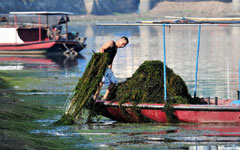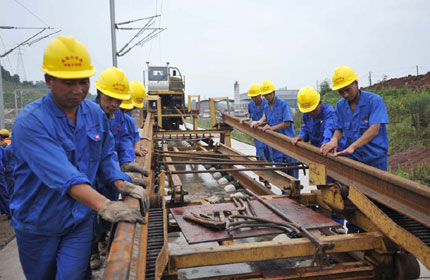China's arid north feeds water-rich south
Updated: 2014-07-08 11:41
(Agencies)
|
|||||||||||
Xinjiang, which has annual rainfall of less than 10 centimeters, exports billions of tons of water each year to Shanghai (where annual rainfall is 1 meter or more) and Guangdong (which receives 2-3 meters per year).
Farming accounts for 98 percent of water consumption in Xinjiang, 84 percent in Inner Mongolia and 83 percent in Hebei, compared with just 67 percent in Guangdong and 31 percent in Shanghai ("Virtual scarce water in China: supplemental data" June 2014).
|
 |
 |
Industrial and water imbalances are worsening China's environmental problems. Northern China is already subjected to dust storms and far worse pollution than the south. Now the region is suffering from increasing water stress.
For example, Zhejiang is a major exporting province on China's east coast. But only 20 percent of the ecological impact of Zhejiang's exports was felt in the province, according to the researchers, while the rest was "outsourced" to other parts of China, including Xinjiang (40 percent), Hebei (7 percent) and Inner Mongolia (5 percent).
Increased use of irrigation and reliance on groundwater have enabled northern provinces to boost agricultural output, but is not sustainable in the long term as regional aquifers fall.
In response, the government's controversial South-North Water Transfer Project aims to send almost 45 billion gallons each year from the Yangtze River through a series of giant canals to Beijing and other parts of the north.
The project, budgeted to cost twice as much as the Three Gorges Dam, is the world's largest civil engineering endeavor and is not scheduled to be fully completed until 2050.
It might be more efficient, however, to encourage northern provinces to reduce their production of water-intensive food and focus on items which have higher value added and lower water content, according to the researchers.
But the government's efforts to encourage more industrial development in the west have so far had limited success. The south's industrial advantage has appeared to become even more entrenched in the last decade, forcing northern areas even deeper into water scarcity.
Related Stories
Chinese water company to invest $1.6b in overseas markets 2014-06-05 16:24
For a drink of clean water, turn on the tap 2014-05-26 07:12
Waters of life flowing through capital city 2014-02-18 07:16
Beijing to build 16 water reclamation plants in 2014 2014-01-25 18:42
China to open another water diversion route 2014-01-16 13:15
China introduces tiered pricing to save water 2014-01-03 14:47
Today's Top News
China, Germany join hands to drive growth
Meet foreigner breed of workers
Product placement deal backfires
From Westlife to the East
Gambling costs World Cup fans their lives
US supports Ukraine's decision to suspend ceasefire
It's all about making a spectacle
China likely to see 7.5% growth in second quarter
Hot Topics
Lunar probe , China growth forecasts, Emission rules get tougher, China seen through 'colored lens', International board,
Editor's Picks

|

|

|

|

|

|





